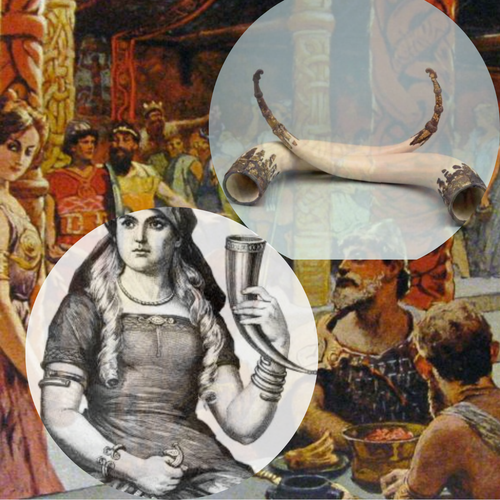
What does the drinking horn symbolize?
Share
Symbolism of the Viking Drinking Horn
The drinking horn was deeply tied to pre-Christian Norse culture. Simply put, in the viking age drinking horns symbolized religious ritual, hospitality, uniting allies, the afterlife and toasting to gods, ancestors and other aspects of the Norse pagan religion. This article goes over all of these sources and uses that these mead horns had.
This is a short summary of the symbolism and used of drinking horns. To see learn the full history of drinking horns in the viking age, see our full article here.
Drinking Horns as a Symbol of Norse Pagan Religion
It is very clear from many sources that drinking horns were deeply tied to pagan tradition ad were strictly forbidden by Christianity. The Synod of Chelsea (787 CE)
in Anglo-Saxon England, the church council labeled drinking horns as sinful objects and their use was outlawed. Similarly the Swedish Dalalagen and Smålandslagen from the 11th–12th centuries prohibit the use of horns, hair, and nail clippings, lumping them together as sinful remnants of pagan practices.
We also see multiple Norse sagas such as the Saga of Olav Tryggvasson or Saga of Haakon the Good, where a Christian Norwegian king refused to take part in the pagan practice of drinking from a horn at certain ceremonies.
We also see in the archeology that drinking horns began to disappear toward the end of the viking age as Christianity spread across Scandinavia. For several centuries, they fell out of use entirely. However, drinking horns made a comeback in the 1400s, although these later horns were crafted from precious metals or glass and adorned with Christian imagery, which were far removed from the livestock-based viking horns of earlier pagan times.
Ale Horns as a Symbol of Hospitality
In Viking society and even in the broader Anglo-Saxon or Germanic culture, offering your guests a mead drinking horn was one of the highest signs of respect and hospitality. In the traditional ritual, "Sumbel" for example, the person serving the drink which was usually a noblewoman, queen or lady of the house.
Serving a viking beer horn wasn’t just about handing someone a drink; it was a ceremonial gesture that marked the guest’s importance and strengthened social bonds. This is told about in some of the early medieval sources such as Beowulf, Lokasenna, Sigrdrífumál, Egils saga and more!
Drinking Horns in Norse Religious Rituals
The Norse drinking horn was also closely tied to religious rituals. Real historical accounts such as the Saga of Haakon the Good describe horns being used to toast the gods, ancestors, or even fallen warriors.
In the story of Odin and his mead of poetry, the mead horn was filled with sacred mead mixed with the blood of the Kvasir to attain the gift of poetry and wisdom. See our horn inspired by this myth here!
There are also clues in our mythology about some sort of initiation ritual where the maiden, goddess, valkyrie, etc. would bring a drink of mead in the horn to the hero in order to provide wisdom, sacred knowledge or some sort of initiation. This is told about quite clearly in the poem Sigrdrífumál, but there are many other similar accounts as Maria Kvilhaug examines in her paper "The Maiden and the Mead." Drinking from a Viking horn in these settings was believed to bring spiritual power, luck, blessings, or initiation.
Mead Horns in Valhalla
Meanwhile, in Valhalla, the Valkyries are said to serve mead horns to the honored dead, symbolizing their eternal unity as warriors in the afterlife. This is told about in the poetic edda poem Grímnismál.
"Hrist and Mist the horn shall bear me,
Skeggjöld and Skögul, Hildr and Þrúðr,
Hlökk and Herfjötur, Göll and Geirólul,
Randgríðr and Ráðgríð and Reginleif
To the einherjar ale shall bear."-Grímnismál
This valkyrie like figure with the drinking horn is also depicted in multiple archeological finds.
Gotland picture stones: These stones depict scenes of feasting or rituals where drinking horns are prominently featured.
Gallehus horns: Famous artifacts from Denmark depicting women holding drinking horns in a serving position.
Gullgubber men: Tiny gold-foil figures from Scandinavia, including Valkyries offering drinking horns.
Runestones: Many runestones from the Viking Age depict women serving drinks with drinking horns, further emphasizing their cultural and spiritual roles.

Beer Horns Conclusion
For the Norse, drinking from a viking drinking horn was an act steeped in tradition, used during feasts, rituals, and ceremonies. The drinking horn is more than just a practical tool, it’s a symbol of community, honor, and connection to the divine in the pre-Christian Norse and Viking culture.
To see our collection of drinking horns inspired by the historical sources and archeological finds, check it out here!
https://norseimports.com/collections/historical-viking-drinking-horns
